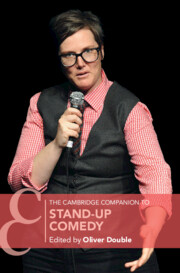
- Coming soon
- Publisher:
- Cambridge University Press
- Expected online publication date:
- August 2025
- Print publication year:
- 2025
- Online ISBN:
- 9781009000635

Stand-up comedy is one of the simplest theatre forms in existence. The comedian stands on a (usually) bare stage, talking straight to the audience in the hope of getting laughs. Yet it has never been more popular, with national scenes developing across every continent except Antarctica. In this insightful and accessibly written volume, diverse chapters explore the subject from many angles, ranging from national scenes, live venues, and recordings to politics, race, sexuality, and the question of offensiveness. Chapters also consider the performance dynamics of stand-up in detail, examining audience, persona, and trauma. Interspersed throughout the chapters are a series of originally commissioned interviews with comedians from nine different countries, including Maria Bamford, Jo Brand, Aditi Mittal, and Rod Quantock, providing rare insights into their craft.
‘This book is an essential guide to the wonderful, rich, wild, silly world of stand-up.’
Josie Long - multi-award-winning comedian
 Loading metrics...
Loading metrics...
* Views captured on Cambridge Core between #date#. This data will be updated every 24 hours.
Usage data cannot currently be displayed.
The PDF of this book is known to have missing or limited accessibility features. We may be reviewing its accessibility for future improvement, but final compliance is not yet assured and may be subject to legal exceptions. If you have any questions, please contact accessibility@cambridge.org.
Allows you to navigate directly to chapters, sections, or non‐text items through a linked table of contents, reducing the need for extensive scrolling.
Provides an interactive index, letting you go straight to where a term or subject appears in the text without manual searching.
You will encounter all content (including footnotes, captions, etc.) in a clear, sequential flow, making it easier to follow with assistive tools like screen readers.
You get concise descriptions (for images, charts, or media clips), ensuring you do not miss crucial information when visual or audio elements are not accessible.
You gain clarity from ARIA (Accessible Rich Internet Applications) roles and attributes, as they help assistive technologies interpret how each part of the content functions.